27 Dec 102 Greatest Films of All-Time
During this once-in-a-lifetime experience, where people are at home, bored out of their minds and sifting through the thousands of movies that are available at their fingertips, I felt that the time was as good as any to unveil my self-compiled “Greatest Films of All-Time”, so people have some choices of good cinema to watch.
These films are not ranked based on my opinion. I tried to find films (using a formula) that are exalted by both critics and audiences and I came up with this list. There are definitely some specific why-is-that-above-that aspects of this list that I may not agree with, but the movies that I have seen on this list are, in my opinion, amazing and the others are from sources that are usually trustworthy. (I excluded documentaries and shorts from the list)
“Gone With the Wind”, “Rio Bravo”, “WALL-E”, “The Wizard of Oz”, “To Be Or Not To Be”, “To Kill a Mockingbird”, “High and Low”, and “Heat” are some movies that just missed the cut.
Hope you enjoy!
102. The Searchers (1956)
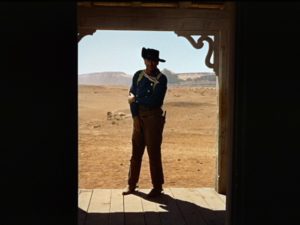
‘The Searchers’ (Warner Bros.)
Directed by: John Ford
One of the great John Ford’s finest films, “The Searchers” is a beautiful Western that is full of moral ambiguity and was voted the 4th Greatest Film of the 20th Century by a Village Voice poll. “After a long three-year absence, the battle-scarred Confederate veteran of the American Civil War, Ethan Edwards (John Wayne), turns up on the remote and dusty Texan homestead of his brother, Aaron (Walter Coy). In high hopes of finding peace, instead, the taciturn former soldier will embark on a treacherous five-year odyssey of retribution, when the ruthless Chief Scar’s (Henry Brandon) murderous Comanche raiding party massacre his family, burn the ranch to the ground and abduct his nine-year-old niece, Debbie (Natalie Wood). Driven by hatred of Indians, Ethan and his young companion, Martin Pawley (Jeffrey Hunter), ride through the unforgiving desert to track down their lost Debbie; however, is the woman they lost and the prisoner in Scar’s teepee still the same woman the searchers seek?” (From IMDb).
101. The Shawshank Redemption (1994)

‘The Shawshank Redemption’ (Columbia)
Directed by: Frank Darabont
“Get busy living, or get busy dying”. This movie is so iconic and I was surprised this tale of perseverance did not make it higher on this list. The performances are top-notch and this is one of Roger Deakins’ best works of cinematography. “In 1946, a banker named Andy Dufresne (Tim Robbins) is convicted of a double murder, even though he stubbornly proclaims his innocence. He’s sentenced to a life term at the Shawshank State Prison in Maine, where another lifer, Ellis “Red” Redding (Morgan Freeman), picks him as the new recruit most likely to crack under the pressure. The ugly realities of prison life are quickly introduced to Andy: a corrupt warden (Bob Gunton), sadistic guards led by Capt. Byron Hadley (Clancy Brown), and inmates who are little better than animals, willing to use rape or beatings to insure their dominance. But Andy does not crack: he has the hope of the truly innocent, which (together with his smarts) allow him to prevail behind bars.” (From Rotten Tomatoes).
100. Annie Hall (1977)
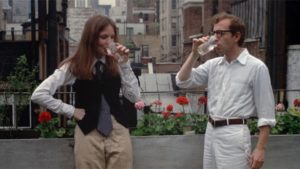
‘Annie Hall’ (United Artists)
Directed by: Woody Allen
Widely acknowledged as Woody Allen’s masterpiece (even if he doesn’t agree), “Annie Hall” is one of the great romantic-comedies and the Best Picture winner is a joy to watch and could bring you some light during this pandemic. “Alvy Singer (Woody Allen), a forty year old twice divorced, neurotic, intellectual Jewish New York stand-up comic, reflects on the demise of his latest relationship, to Annie Hall (Diane Keaton), an insecure, flighty, Midwestern WASP aspiring nightclub singer. Unlike his previous relationships, Alvy believed he may have worked out all the issues in his life through fifteen years of therapy to make this relationship with Annie last, among those issues being not wanting to date any woman that would want to date him, and thus subconsciously pushing those women away. Alvy not only reviews the many ups and many downs of their relationship, but also reviews the many facets of his makeup that led to him starting to date Annie. Those facets include growing up next to Coney Island in Brooklyn, being attracted to the opposite sex for as long as he can remember, and enduring years of Jewish guilt with his constantly arguing parents.” (From IMDb).
99. Do the Right Thing (1989)
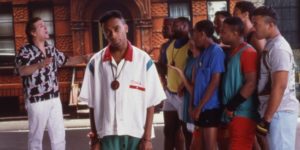
‘Do the Right Thing’ (Universal)
Directed by: Spike Lee
Spike Lee’s honest, visually-impressive masterpiece, “Do the Right Thing” is an unflinching portrait of race relations in America and is still relevant and timely today. It is essential viewing, never boring, and has an amazing soundtrack. “This film looks at life in the Bedford-Stuyvesant district of Brooklyn on a hot summer Sunday. As he does everyday, Sal Fragione (Danny Aiello) opens the pizza parlor he’s owned for 25 years. The neighborhood has changed considerably in the time he’s been there and is now composed primarily of African-Americans and Hispanics. His son Pino (John Turturro) hates it there and would like nothing better than to relocate the eatery to their own neighborhood…What begins as a simple complaint by one of his customers, Buggin Out (Giancarlo Esposito) – who wonders why he has only pictures of famous Italian-Americans on the wall when most of his customers are black – eventually disintegrates into violence as frustration seemingly brings out the worst in everyone. (From IMDb).
98. La Strada (1954)

‘La Strada’ (Paramount Films of Italy)
Directed by: Federico Fellini
Probably Fellini’s most accesible film, “La Strada” is instantly alluring and Giulietta Masina’s charming and vulnerable performance as naïve Gelsomina is spectacular. “Godfather” composer Nino Rota’s score is achingly beautiful and Anthony Quinn’s performance as the brutish Zampano is probably the best of his career. “Gelsomina (Giulietta Masina) lives a quiet life with her mother and three sisters. However, this sheltered existence is shattered when a travelling showman, Zampano (Anthony Quinn), pays her mother so that Gelsomina will travel with and work for him. She is initially a reluctant participant in his line of work but soon tries to make the most of it, even learning some new skills. However, she has to contend with his brutish, unfeeling behavior.” (From IMDb).
97. Amadeus (1984)

‘Amadeus’ (Orion Pictures)
Directed by: Milos Forman
One of the greatest biopics of all time, (even though it definitely isn’t fully historically accurate) “Amadeus” is so, so entertaining to watch and its epic 2 hour and 40 min length just flies by. With superb production design and a stellar, Oscar-winning turn from F. Murray Abraham as Salieri, Mozart’s greatest rival, the film is an exquisite portrait of a genius. “Wolfgang Amadeus Mozart (Tom Hulce) is a remarkably talented young Viennese composer who unwittingly finds a fierce rival in the disciplined and determined Antonio Salieri (F. Murray Abraham). Resenting Mozart for both his hedonistic lifestyle and his undeniable talent, the highly religious Salieri is gradually consumed by his jealousy and becomes obsessed with Mozart’s downfall, leading to a devious scheme that has dire consequences for both men.” (From IMDb).
96. The Thing (1982)
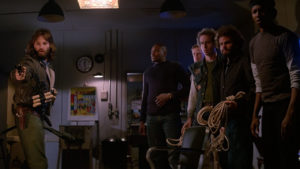
‘The Thing’ (Universal)
Directed by: John Carpenter
“Halloween” director John Carpenter knows how to develop dread and suspense in his films and The Thing is a masterclass in those techniques. It is terrifying and always keeps you on the edge your seat. “A US research station, Antarctica, early-winter 1982. The base is suddenly buzzed by a helicopter from the nearby Norwegian research station. They are trying to kill a dog that has escaped from their base. After the destruction of the Norwegian chopper the members of the US team fly to the Norwegian base, only to discover them all dead or missing. They do find the remains of a strange creature the Norwegians burned. The Americans take it to their base and deduce that it is an alien life form. After a while it is apparent that the alien can take over and assimilate into other life forms, including humans, and can spread like a virus. This means that anyone at the base could be inhabited by The Thing, and tensions escalate.” (From IMDb).
95. Jaws (1975)
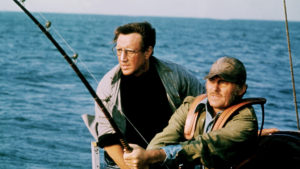
‘Jaws’ (Universal)
Directed by: Steven Spielberg
Widely-acknowleged as the first summer blockbuster and Steven Spielberg’s breakout film (“Duel” was a semi-breakout), “Jaws” is always thrilling and its opening scene is one of the most iconic and greatest tone-setting scenes in film history. “When new Sheriff Martin Brody (Roy Scheider) discovers the remains of a shark attack victim, his first inclination is to close the beaches to swimmers. This doesn’t sit well with Mayor Larry Vaughn (Murray Hamilton) and several of the local businessmen. Brody backs down to his regret as that weekend a young boy is killed by the predator. The dead boy’s mother (Lee Fierro) puts out a bounty on the shark and Amity is soon swamped with amateur hunters and fisherman hoping to cash in on the reward. A local fisherman with much experience hunting sharks, Quint (Robert Shaw), offers to hunt down the creature for a hefty fee. Soon Quint, Brody and Matt Hooper (Richard Dreyfuss) from the Oceanographic Institute are at sea hunting the Great White shark. As Brody succinctly surmises after their first encounter with the creature, they’re going to need a bigger boat.” (From IMDb).
94. Aliens (1986)

‘Aliens’ (20th Century Fox)
Directed by: James Cameron
A shift from the claustrophobic terror that was Ridley Scott’s “Alien”, “Aliens” leans more into the action-adventure aspects of its setting and delivers, providing an exhilarating experience that gives you all the thrills. “57 years after Ellen Ripley (Sigourney Weaver) had a close encounter with the reptilian alien creature from the first movie, she is called back, this time, to help a group of highly trained colonial marines fight off against the sinister extraterrestrials. But this time, the aliens have taken over a space colony on the moon LV-426. When the colonial marines are called upon to search the deserted space colony, they later find out that they are up against more than what they bargained for. Using specially modified machine guns and enough firepower, it’s either fight or die as the space marines battle against the aliens. As the Marines do their best to defend themselves, Ripley must attempt to protect a young girl who is the sole survivor of the decimated space colony.” (From IMDb).
93. The Big Lebowski (1998)

‘The Big Lebowski’ (Gramercy)
Directed by: The Coen Brothers
Jeff Bridges’ The Dude is one of the most recognizable figures in cinema history and the film he inhabits is also very memorable. Putting a twist on 50’s crime noirs, the Big Lebowski, with its fun dialogue and musical numbers, feels wholly original. “Jeffrey “The Dude” Lebowski’s (Jeff Bridges) the ultimate Los Angeles slacker. One day, his house is broken into, and his rug is urinated on by 2 angry hired heavies who’ve mistaken him for another Jeffrey Lebowski, that one’s a Los Angeles millionaire, whose wife owes some people big money. The Dude becomes entangled in his namesake’s problem when he goes to visit the other Lebowski in order to get some recompense for his soiled rug. Instead, he’s offered a job for a lot of money; act as liaison between Lebowski and the captors of his now “kidnapped” wife.” (From IMDb).
92. The Night of the Hunter (1955)

‘The Night of the Hunter’ (United Artists)
Directed by: Charles Laughton
The eerie, gothic quality of this amazing film is what keeps its images in your head long after the credits roll. Robert Mitchum’s performance as the very personification of evil also helps to elevate director Charles Laughton’s sole feature (Side note: They are apparently remaking the film, so watch it beforehand!). “Combining stark realism with Germanic expressionism, the movie is a brilliant good-and-evil parable, with “good” represented by a couple of farm kids and a pious old lady, and “evil” literally in the hands of a posturing psychopath. Imprisoned with thief Ben Harper (Peter Graves), phony preacher Harry Powell (Robert Mitchum) learns that Ben has hidden a huge sum of money somewhere near his home. Upon his release, the murderously misogynistic Powell insinuates himself into Ben’s home, eventually marrying his widow Willa (Shelley Winters). Eventually all that stands between Powell and the money are Ben’s son (Billy Chapin) and daughter (Sally Jane Bruce), who take refuge in a home for abandoned children presided over by the indomitable, scripture-quoting Rachel Cooper (Lillian Gish).” (From Rotten Tomatoes).
91. Reservoir Dogs (1992)
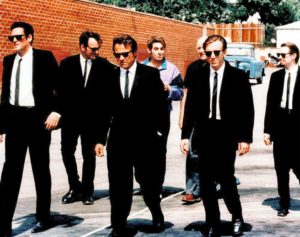
‘Reservoir Dogs’ (Miramax)
Directed by: Quentin Tarantino
Celebrated for a great contrapuntal music choice and just the overall “coolness” it emanates, “Reservoir Dogs” is a Tarantino thriller that keeps your attention and heart racing throughout even through some brutally violent scenes. “Six criminals (Harvey Keitel, Tim Roth, Michael Madsen, Steve Buscemi, Edward Bunker, Quentin Tarantino), who are strangers to each other, are hired by a crime boss, Joe Cabot, to carry out a diamond robbery. Right at the outset, they are given false names with the intention that they won’t get too close and will concentrate on the job instead. They are completely sure that the robbery is going to be a success. But, when the police show up right at the time and the site of the robbery, panic spreads amongst the group members, and two of them are killed in the subsequent shootout, along with a few policemen and civilians. When the remaining people assemble at the premeditated rendezvous point (a warehouse), they begin to suspect that one of them is an undercover cop.” (From IMDb).
90. The Man Who Shot Liberty Valance (1962)

‘The Man Who Shot Liberty Valance’ (Paramount)
Directed by: John Ford
“The Man Who Shot Liberty Valance” cements John Ford’s place as the master of the Hollywood Western with a plot that touches on political issues that are still relevant today and a pair of great performances from Hollywood titans James Stewart and John Wayne. “Eastern attorney Ranson Stoddard (James Stewart) heads to the wild West in search of a new life. He settles in the small town of Shinbone where he meets up with Liberty Valance (Lee Marvin). Valance is as bad a villain as there ever was, and his dastardly deeds are financed by an evil conglomerate resolute on stopping the territory from gaining statehood. When Valance beats Stoddard to a bloody pulp, Stoddard is rescued by rancher Tom Doniphon (John Wayne). Tom helps Ranson to a nearby restaurant where owner Hallie (Vera Miles) who patches him up and gives him a job as table server.” (From Rotten Tomatoes).
89. Mulholland Drive (2001)

‘Mulholland Drive’ (Universal)
Directed by: David Lynch
Probably Lynch’s best work, “Mulholland Drive” is a deftly-crafted thriller that casts a sinister tone over the image of Hollywood. It is obviously a Lynch film and therefore it is best not to say too much about it, so not to spoil the experience for others. “After a brutal car accident in Los Angeles, California, Rita (Laura Harring) is the sole survivor but suffers mass amnesia. Wandering into a strangers apartment downtown, her story strangely intertwines with Betty Elms (Naomi Watts), a perky young woman in search of stardom. However, Betty is intrigued by Rita’s situation and is willing to put aside her dreams to pursue this mystery. The two women soon discover that nothing is as it seems in the city of dreams.” (From IMDb).
88. La Dolce Vita (1960)

‘La Dolce Vita’ (Cineriz)
Directed by: Federico Fellini
One of Roger Ebert’s favorite films, “La Dolce Vita” is a film that blends Fellini’s more Italian neorealist works (La Strada, Nights of Cabiria) of his early career and the more surreal films (8 1/2, Amarcord) of his later years. This turning point in his career is a poignant, beautiful tale that settles in both the viewer’s mind and heart. “Rome, 1959/60. Marcello Rubini (Marcello Mastroianni) is a writer and journalist, the worst kind of journalist – a tabloid journalist, or paparazzo. His job involves him trying to catch celebrities in compromising or embarrassing situations. He tends to get quite close to his subject, especially when they’re beautiful women. Two such subjects are a local heiress, Maddalena (Anouk Aimee), and a Swedish superstar-actress, Sylvia (Anita Ekberg), both of whom he has affairs with. This is despite being engaged to Emma (Yvonne Furneaux), a rather clingy, insecure, nagging, melodramatic woman. Despite his extravagant, pleasure-filled lifestyle, he is wondering if maybe a simpler life wouldn’t be better..” (From IMDb).
87. The Kid

‘The Kid’ (First National)
Directed by: Charlie Chaplin
A fun and heartwarming film, this Chaplin silent comedy is a treat due to Chaplin’s trademark balance of pathos and comedy. Jackie Coogan is astonishing in his first credited role and is the heart of the film. “A woman (Edna Purviance) decides to abandon her baby in the backseat of an automobile with a handwritten note attached, beseeching the finder to care for and love the child. When the car is stolen by thieves, who discover the baby in the backseat, they subsequently leave him on the street. The child is discovered by the initially reluctant Tramp (Charlie Chaplin) who eventually softens and comes to love him as his own. As the child (Jackie Coogan) grows up, both he and The Tramp must learn to navigate through a life that spawns one adventure after another.” (From IMDb).
86. The Red Shoes (1948)
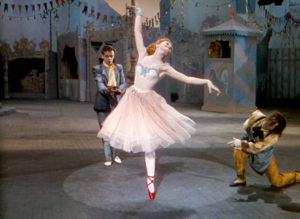
‘The Red Shoes’ (General Film Distribution)
Directed by: Michael Powell and Emeric Pressburger
With great ballet scenes and an outstanding score from Brian Easdale, “The Red Shoes” is a vibrant fable about love and ambition. It also happens to be one of Martin Scorsese’s favorite films. “Under the authoritarian rule of charismatic ballet impressario Boris Lermontov (Anton Walbrook), his proteges realize the full promise of their talents, but at a price: utter devotion to their art and complete loyalty to Lermontov himself. Under his near-obsessive guidance, young ballerina Victoria Page (Moira Shearer) is poised for superstardom, but earns Lermontov’s scorn when she falls in love with Julian Craster (Marius Goring), composer of “The Red Shoes,” the ballet Lermontov is staging to showcase her talents. Vicky leaves the company and marries Craster, but still finds herself torn between Lermontov’s demands and those of her heart. ” (From IMDb).
85. Breathless (1960)
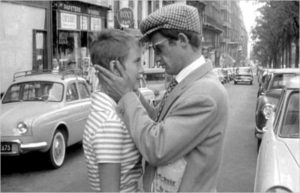
‘Breathless’ (Les Films Imperia)
Directed by: Jean-Luc Godard
Famed for its pioneering use of jump cuts, “Breathless” changed cinema forever and its revolutionary elements can still be seen throughout movies today. One of the earliest films of the French New Wave movement, (Francois Truffaut’s “The 400 Blows” (1959) and Alain Resnais’ “Hiroshima mon Amour” (1959) being the two French New Wave films that came before it) the film feels real and its narcissistic characters are a joy to behold. “Michel Poiccard (Jean-Paul Belmondo), an irresponsible sociopath and small-time thief, steals a car and impulsively murders the motorcycle policeman who pursues him. Now wanted by the authorities, he renews his relationship with Patricia Franchini (Jean Seberg), a hip American girl studying journalism at the Sorbonne, whom he had met in Nice a few weeks earlier. Before leaving Paris, he plans to collect a debt from an underworld acquaintance and expects her to accompany him on his planned getaway to Italy.” (From IMDb).
84. Touch of Evil (1958)

‘Touch of Evil’ (Universal)
Directed by: Orson Welles
Celebrated for a masterful opening sequence (that is referenced in Robert Altman’s “The Player” (1992)) and some amazing cinematography from Russell Metty, Orson Welles’ second most-acclaimed film is thrilling and was a trendsetter for a hundreds of crime films to come. “Mexican Narcotics officer Ramon Miguel ‘Mike’ Vargas (Charlton Heston) has to interrupt his honeymoon on the Mexican-US border when an American building contractor is killed after someone places a bomb in his car. He’s killed on the US side of the border but it’s clear that the bomb was planted on the Mexican side. As a result, Vargas delays his return to Mexico City where he has been mounting a case against the Grandi family crime and narcotics syndicate. Police Captain Hank Quinlan (Orson Welles) is in charge on the US side and he soon has a suspect, a Mexican named Manolo Sanchez (Victor Millan). Vargas is soon onto Quinlan and his Sergeant, Pete Menzies (Joseph Calleia), when he catches them planting evidence to convict Sanchez. With his new American wife, Susie (Janet Leigh), safely tucked away in a hotel on the US side of the border – or so he thinks – he starts to review Quinlan’s earlier cases. While concentrating on the corrupt policeman however, the Grandis have their own plans for Vargas and they start with his wife Susie.” (From IMDb).
83. The Rules of the Game (1939)
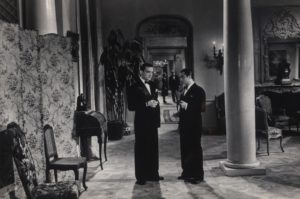
‘The Rules of the Game’ (La Distribution Parisiene)
Directed by: Jean Renoir
Very daring for its time, “The Rules of the Game” was banned for being too depressing, probably due to its complex social criticism. It is also one of the most critically-beloved films of all-time and was voted as the 4th greatest film of all-time on the 2012 Sight and Sound poll. “On the brink of WWII, the record-breaking aviator, André Jurieux (Roland Toutain), safely lands at a small airport crammed with reporters, only to come face to face with his worst fear: the object of his desire, Christine (Nora Gregor)–a blonde noblewoman and wife of the affluent Marquis de la Cheyniest, Robert (Marcel Dalio)–is not there to greet him. Intent on winning her back, André accepts his friend Octave’s (Jean Renoir) invitation for a lavish hunting weekend at the aristocrat’s palatial country estate at La Coliniere, among hand-picked guests and the mansion’s servants; however, intrigue, rivalries, and human weaknesses threaten to expose both royalty and paupers alike. Who will breach the unwritten rules of the game?” (From IMDb).
82. Battleship Potemkin (1925)
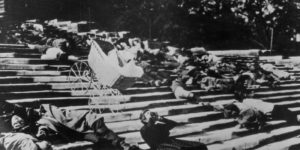
‘Battleship Potemkin’ (Goskino)
Directed by: Sergei Eisenstein
Famous for the Odessa Steps sequence (which was memorably referenced in Brian de Palma’s “The Untouchables” (1987)) and its pioneering use of the montage, “Battleship Potemkin” is a massive film that is both brutal and beautiful. “Based on actual events that occurred at the port of Odessa in 1905, the crew of the battleship Potemkin mutiny after yet again being served rotten food. At the time, there was growing opposition to Imperialist rule and a mini revolution was soon underway. The revolt was harshly put down by government troops with the shooting of civilians – including women and children – on the Odessa Steps.” (From IMDb).
81. The Treasure of the Sierra Madre (1948)

‘The Treasure of the Sierra Madre’ (Warner Bros.)
Directed by: John Huston
Intelligent comments on human nature seen through a thrilling Western adventure, “The Treasure of the Sierra Madre” is arguably John Huston’s masterpiece and is an emotional experience about obsession and greed. “Fred C. Dobbs (Humphrey Bogart) and Bob Curtin (Tim Holt), both down on their luck in Tampico, Mexico in 1925, meet up with a grizzled prospector named Howard (Walter Huston) and decide to join with him in search of gold in the wilds of central Mexico. Through enormous difficulties, they eventually succeed in finding gold, but bandits, the elements, and most especially greed threaten to turn their success into disaster.” (From IMDb).
80. The Battle of Algiers (1966)

‘The Battle of Algiers’ (Magna)
Directed by: Gillo Pontecorvo
A brutal and harrowing experience, like all good war films should be, “The Battle of Algiers” is a movie that feels very real and it creates complex characters on both sides of the battle. Pontecorvo used non-professional actors to heighten the realism and also uses handheld camera sequences to increase the intensity, all coalescing into a singular and extremely memorable experience. “Filmed in a semi-documentary format, this film deals with the battle of Algiers (1956-57) part of the broader fight for Algerian independence (1954-62) from French colonial rule. The rebels began their attacks by shooting policeman and other government officials. When they start bombing public places in the European sector – cafés, restaurants, the Air France office – the authorities send in crack military units. Through large-scale arrests and torture, the colonel (Jean Martin) in charge focuses on locating and eliminating the leaders of the movement.” (From IMDb).
79. The Silence of the Lambs
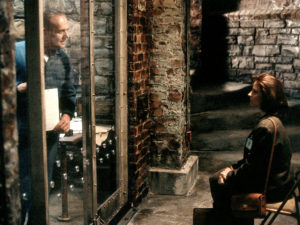
‘The Silence of the Lambs’ (Orion)
Directed by: Jonathan Demme
A disturbing, thrilling, and a masterclass in creating atmosphere, “The Silence of the Lambs” is impossible to take your eyes off of and contains powerhouse performances from Anthony Hopkins as Hannibal Lecter and Jodie Foster as Clarice Starling. Their exchanges are so iconic at this point that you have probably seen clips of their first meeting even if you haven’t seen the film. All of these factors allowed the film to become the 3rd film (It Happened One Night and One Flew Over the Cuckoo’s Nest are the other two) ever to receive the “Big Five” (Best Picture, Best Director, Best Actor, Best Actress, and either Best Adapted Screenplay or Best Original Screenplay) at the Oscars. “Perplexed by a string of grisly murders elaborately executed by the elusive mass killer nicknamed “Buffalo Bill”, the vulnerable and untried F.B.I. trainee, Clarice Starling (Jodie Foster), is assigned by the Special Agent, Jack Crawford (Scott Glenn), to assist in the manhunt. Hoping to attain a clearer perception of the psychopathic serial killer’s modus operandi, the young investigator reluctantly accepts the help of another hideous monster: the brilliant psychiatrist and cannibalistic mass murderer, Dr. Hannibal Lecter (Anthony Hopkins). Now, with every visit to the manipulative doctor’s heavily reinforced prison cell, Clarice delves just a little bit deeper into the dark mind of a homicidal maniac; however, how far is she willing to go to unearth pure evil?” (From IMDb).
78. My Neighbor Totoro (1988)

‘My Neighbor Totoro’ (Toho)
Directed by: Hayao Miyazaki
A beautifully animated film about childhood that transports viewers back to the carefree nature of their youth, “My Neighbor Totoro” is one of Studio Ghibli’s best works (and happens to be its face marketing-wise) and seamlessly weaves together fantasy elements with character and emotion, which is Ghibli’s trademark. “Two young girls, 10-year-old Satsuki (Noriko Hidaka) and her 4-year-old sister Mei (Chika Sakamoto), move into a house in the country with their father (Shigesato Itoi) to be closer to their hospitalized mother (Sumi Shimamoto). Satsuki and Mei discover that the nearby forest is inhabited by magical creatures called Totoros (pronounced toe-toe-ro). They soon befriend these Totoros, and have several magical adventures.” (From IMDb).
77. Fargo (1996)

‘Fargo’ (Gramercy)
Directed by: The Coen Brothers
Joel and Ethan Coen’s masterpiece, “Fargo” is a brilliant black comedy-thriller that features a compelling Oscar-winning turn from Frances McDormand and some very memorable performances from William H. Macy and Steve Buscemi (Side Note: How has Buscemi never been nominated for an Oscar?). “Jerry Lundegard (William H. Macy) is in an unknown financial jam and wants his father-in-law’s money to solve it. His plan to get the money involves hiring Carl Showalter (Steve Buscemi) and Gaer Grimsrud (Peter Stormare) to kidnap his wife, and then splitting the ransom with the criminals. However, this quickly falls apart after three killings and the persistent work of chirpy but efficient police chief, the pregnant Marge Gunderson (Frances McDormand).” (From IMDb).
76. All About Eve (1950)
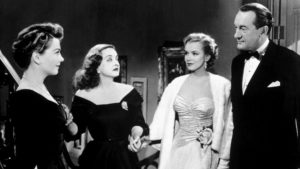
‘All About Eve’ (20th Century Fox)
Directed by: Joseph L. Mankiewicz
With an electric screenplay and some powerhouse performances from Bette Davis, Anne Baxter, and George Sanders, “All About Eve” is a timeless critique on show business and effortlessly watchable. “Eve Harrington (Anne Baxter) is waiting backstage to meet her idol, talented but aging Broadway star Margo Channing (Bette Davis). It seems innocent enough as Eve explains that she has seen Margo in EVERY performance of her current play. Margo and her friends take Eve under their wing but only theatre critic Addison DeWitt (George Sanders) sees through Eve’s evil plan, which is to take Margo’s parts and her fiancé, Bill Simpson (Gary Merrill) too.”
75. La Grande Illusion (1937)
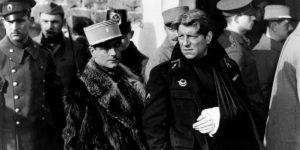
‘La Grande Illusion’ (RAC)
Directed by: Jean Renoir
One of the greatest WW1 films and one that Franklin Roosevelt apparently loved, “La Grande Illusion” is an achievement of filmmaking that challenges the “illusions” that people can experience during wartime, such as the illusion of superiority. It was a very timely film then and will forever be. “During WW1, two French officers (Pierre Fresnay and Jean Gabin) are captured by Germans and are imprisoned in a German P.O.W. camp. These two become very friendly with one another due to their mutual respect. They attempt to escape, and they are sent to a castle that has been converted into an impenetrable P.O.W. camp” (From me).
74. Ran (1985)

‘Ran’ (Toho)
Directed by: Akira Kurosawa
The great Akira Kurosawa’s last masterpiece, “Ran” is an adaptation of Shakespeare’s timeless “King Lear” and is a grand, sprawling epic with amazing production design and cinematography, as well as genuine emotion. “Japanese warlord Hidetori Ichimonji (Tatsuya Nakadai) decides the time has come to retire and divide his fiefdom among his three sons. His eldest and middle sons – Taro (Akira Terao) and Jiro (Jinpachi Nezu) – agree with his decision and promise to support him for his remaining days. The youngest son Saburo (Daisuke Ryu) disagrees with all of them arguing that there is little likelihood the three brothers will remain united. Insulted by his son’s brashness, the warlord banishes Saburo. As the warlord begins his retirement, he quickly realizes that his two eldest sons [are] selfish and have no intention of keeping their promises. It leads to war and only banished Saburo can possibly save him. ” (From IMDb).
73. Back to the Future (1985)
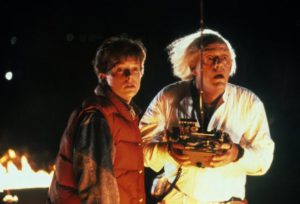
‘Back to the Future’ (Universal)
Directed by: Robert Zemeckis
“Back to the Future” is basically perfect entertainment, it’s funny, it’s thrilling, it’s pretty original and it as a couple of unforgettable characters in Marty McFly and Doc Brown. “In this 1980s sci-fi classic, small-town California teen Marty McFly (Michael J. Fox) is thrown back into the ’50s when an experiment by his eccentric scientist friend Doc Brown (Christopher Lloyd) goes awry. Traveling through time in a modified DeLorean car, Marty encounters young versions of his parents (Crispin Glover and Lea Thompson), and must make sure that they fall in love or he’ll cease to exist. Even more dauntingly, Marty has to return to his own time and save the life of Doc Brown. (From IMDb).
72. The Mirror (1975)
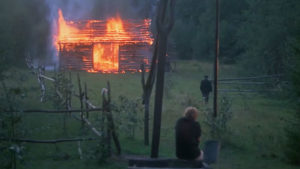
‘The Mirror’ (Mosfilm)
Directed by: Andrei Tarkovsky
A masterclass in poetic visual filmmaking, “The Mirror” is Andrei Tarkovsky’s visual and emotional style operating on their highest levels. Each individual frame of this film is beautiful and meaningful and they come together to create an indelible experience. “A dying man in his forties remembers his past. His childhood, his mother, the war, personal moments and things that tell of the recent history of all the Russian nation.” (From IMDb).
71. Unforgiven (1992)

‘Unforgiven’ (Warner Bros.)
Directed by: Clint Eastwood
One of the greatest post-60s Westerns, “Unforgiven” is Clint Eastwood’s most compelling directorial effort and it strikes a harmonious balance between the modern and the mythic gun-slinging fables of the 60s. “Retired Old West gunslinger William Munny (Clint Eastwood) reluctantly takes on one last job, with the help of his old partner Ned Logan (Morgan Freeman) and a young man, The “Schofield Kid” (Jaimz Woolvett).” (From IMDb).
70. Cinema Paradiso (1988)
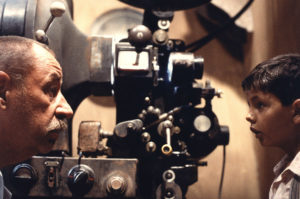
‘Cinema Paradiso’ (Titanus)
Directed by: Giuseppe Tornatore
When watching “Cinema Paradiso”, the audience can really feel Tornatore’s love of movies emanating from the screen. It’s a movie dedicated to the power of cinema and to the people who can’t live without the medium. “A boy who grew up in a native Sicilian Village returns home as a famous director (Jacques Perrin) after receiving news about the death of an old friend. Told in a flashback, Salvatore reminiscences about his childhood and his relationship with Alfredo (Philippe Noiret), a projectionist at Cinema Paradiso. Under the fatherly influence of Alfredo, Salvatore (Salvatore Cascio) fell in love with film making, with the duo spending many hours discussing about films and Alfredo painstakingly teaching Salvatore the skills that became a stepping stone for the young boy into the world of film making.” (From IMDb).
69. On the Waterfront (1954)

“On the Waterfront’ (Columbia)
Directed by: Elia Kazan
A movie that boasts an unforgettable performance from Marlon Brando (he won an Oscar for it) and excellent ones from its many supporting players (Eva Marie Saint won an Oscar for her performance in this film as well), “On the Waterfront” won 8 Oscars for a reason and is a powerful work that transcends time. “Terry Malloy (Marlon Brando) dreams about being a prize fighter, while tending his pigeons and running errands at the docks for Johnny Friendly (Lee J. Cobb), the corrupt boss of the dockers union. Terry witnesses a murder by two of Johnny’s thugs, and later meets the dead man’s sister (Eva Marie Saint) and feels responsible for his death. She introduces him to Father Barry (Karl Malden), who tries to force him to provide information for the courts that will smash the dock racketeers.” (From IMDb).
68. City of God (2002)
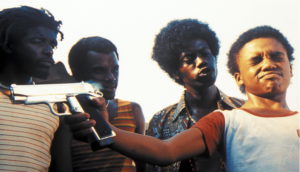
‘City of God’ (Miramax)
Directed by: Fernando Meirelles and Katia Lund
A frenetic and shocking ride that takes the viewer into the slums of Rio, “City of God” is a brutal film that also contains important social commentary about poverty and crime. “The story is told through the eyes of Buscape (Alexandre Rodrigues), a poor young fisherman’s son who dreams of becoming a photographer one day. His story narrates the violence and corruption surrounding the city and the rise and fall of one of the city’s most notorious bosses, Li’l Ze (Leandro Firmino). As war wages on the streets Buscape’s only way out of this violent life is to expose its brutality to the world through his pictures. Along the way the lives of others are put into perspective as their stories intersect with the events that take place.” (From IMDb).
67. Eternal Sunshine of the Spotless Mind (2004)

‘Eternal Sunshine of the Spotless Mind’ (Focus Features)
Directed by: Michel Gondry
Charlie Kaufman’s greatest work and the one he won his overdue Best Original Screenplay Oscar for, “Eternal Sunshine of the Spotless Mind” is full of wisdom about love and life and is an imaginative mindbender that has two superb performances from Jim Carrey (How’d he not get an Oscar nom for this?) and Kate Winslet. “A man, Joel Barish (Jim Carrey), heartbroken that his girlfriend Clementine (Kate Winslet) underwent a procedure to erase him from her memory, decides to do the same. However, as he watches his memories of her fade away, he realizes that he still loves her, and may be too late to correct his mistake.” (From IMDb).
66. There Will Be Blood (2007)
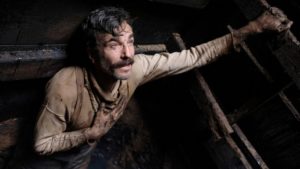
‘There Will Be Blood’ (Paramount Vantage)
Directed by: Paul Thomas Anderson
Containing the (arguably) greatest performance from one of the greatest actors of our time, “There Will Be Blood” is a modern classic that is a tale about oil and greed that had parallels to the current world oil situation at the time of release and still does today. “Ruthless silver miner, turned oil prospector, Daniel Plainview (Daniel Day-Lewis) moves to oil-rich California. Using his adopted son (Dillon Freasier) to project a trustworthy, family-man image, Plainview cons local landowners into selling him their valuable properties for a pittance. However, local preacher Eli Sunday (Paul Dano) suspects Plainview’s motives and intentions, starting a slow-burning feud that threatens both their lives.” (From IMDb).
65. Sunrise (1927)
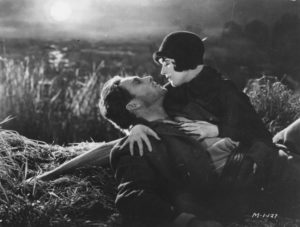
‘Sunrise’ (Fox)
SOURCE CREDIT – “British Film Institute”
Directed by: F.W. Murnau
Apparently the first mainstream film to show a man crying (don’t quote me on this, I’m not 100% about it), “Sunrise” is an emotional film that is an allegorical tale about good and evil. “A woman (Margaret Livingston) from the city holidays in the country. There she has an affair with a local farmer (George O’Brien), a happily married man with a young child. He is besotted with her and the life she promises for him, to the point that, upon her suggestion, he is willing to drown his wife (Janet Gaynor) in order to be with her. With the murder planned, he sets the wheels in motion. Will he go through with it?” (From IMDb).
64. Sherlock Jr. (1924)

‘Sherlock Jr.’ (Metro)
Directed by: Buster Keaton
One of the greatest silent comedies from one of the greatest silent comedians, “Sherlock Jr.” is a masterclass in timing and slapstick comedy and contains famous scenes including an amazing dream sequence. “A young man (Buster Keaton) works as a projectionist at a movie theatre but dreams of becoming a famous detective. His studies toward this goal are put to the test when visiting his girlfriend (Kathryn McGuire). A rival steals his girlfriend’s father’s watch and frames him for the crime. He is forbidden from seeing her again. Now he must fight to clear his name.” (From IMDb).
63. Pather Panchali (1955)
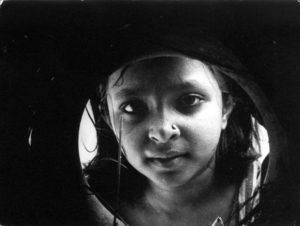
‘Pather Panchali’ (Curzon)
Directed by: Satyajit Ray
The most critically-acclaimed Indian film of all-time, “Pather Panchali” is Satyajit Ray’s first and greatest installment in his Apu trilogy (which includes Aparajito (1956) and Apur Sansar (1959)) and is a lyrical masterwork that is the most powerful film that was released in the greatest decade for Indian cinema (Two other masterworks, Guru Dutt’s Pyaasa (1954) and Mehboob Khan’s Mother India (1957) were also made during this decade). “The story of a young boy, Apu (Subir Banerjee), and life in his small Indian village. His parents are quite poor – his father Harihar (Kanu Bannerjee), a writer and poet, gave away the family’s fruit orchard to settle his brother’s debts. His sister Durga (Uma Das Gupta) and an old aunt also still lives with them. His mother Sarbojaya (Karuna Bannerjee) bears the brunt of the family’s situation. She scrapes by and sells her personal possessions to put food on the table and has to bear the taunts of her neighbors as Durga is always stealing fruit from their orchard. Things get worse when Harihar disappears for five months and Durga falls ill.” (From IMDb).
62. The Matrix (1999)
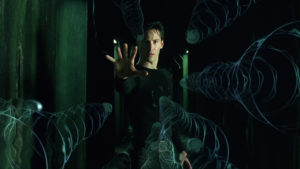
‘The Matrix’ (Warner Bros.)
Directed by: Lana and Lilly Wachowski
Like previously-mentioned “Pather Panchali”, “The Matrix” also has two sequels (and they’re making another), however unlike Pather Panchali’s successive chapters, those sequels were pretty lackluster. Still, that should not take away from how innovative “The Matrix” was. It was an extremely visually-impressive at the time of its release (and still is), but will transcend time is its philosophical messaging and transfixing entertainment value. “Thomas A. Anderson (Keanu Reeves) is a man living two lives. By day he is an average computer programmer and by night a hacker known as Neo. Neo has always questioned his reality, but the truth is far beyond his imagination. Neo finds himself targeted by the police when he is contacted by Morpheus (Laurence Fishburne), a legendary computer hacker branded a terrorist by the government. Morpheus awakens Neo to the real world, a ravaged wasteland where most of humanity have been captured by a race of machines that live off of the humans’ body heat and electrochemical energy and who imprison their minds within an artificial reality known as the Matrix. As a rebel against the machines, Neo must return to the Matrix and confront the agents: super-powerful computer programs devoted to snuffing out Neo and the entire human rebellion.” (From IMDb).
61. Fanny and Alexander (1982)
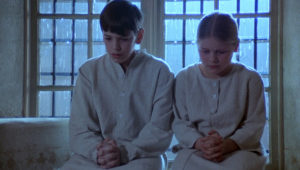
‘Fanny and Alexander’ (Sandrew)
Directed by: Ingmar Bergman
A period epic with stupendous production design and cinematography, “Fanny and Alexander” is funny and devastating, hopeful and haunting. “As children in the loving Ekdahl family, Fanny (Pernilla Alwin) and Alexander (Bertil Guve) enjoy a happy life with their parents, who run a theater company. After their father dies unexpectedly, however, the siblings end up in a joyless home when their mother, Emilie, marries a stern bishop (Jan Malmsjö). The bleak situation gradually grows worse as the bishop becomes more controlling, but dedicated relatives make a valiant attempt to aid Emilie, Fanny and Alexander.” (From IMDb).
60. Empire Strikes Back (1980)
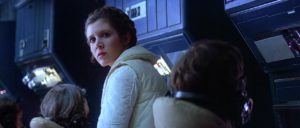
‘Empire Strikes Back’ (20th Century Fox)
Directed by: Irvin Kershner
My favorite Star Wars movie, “Empire Strikes Back” deftly balances emotional resonance with technical brilliance to great effect. A darker installment than the previous “A New Hope”, the film is filled with iconic moments, from the introduction of Yoda on the planet (and star system) Dagobah to Han and Leia’s chemistry-filled exchanges, and the often misquoted, “No, I am your father”. “Luke Skywalker (Mark Hamill), Han Solo (Harrison Ford), Princess Leia (Carrie Fisher) and Chewbacca (Peter Mayhew) face attack by the Imperial forces and its AT-AT walkers on the ice planet Hoth. While Han and Leia escape in the Millennium Falcon, Luke travels to Dagobah in search of Yoda (Frank Oz). Only with the Jedi Master’s help will Luke survive when the Dark Side of the Force beckons him into the ultimate duel with Darth Vader (David Prowse).” (From IMDb).
59. 8 1/2 (1963)

8 1/2 (Cineriz)
Directed by: Federico Fellini
From its famous opening kite sequence onwards, the semi-autobiographical “8 1/2” is a spellbinding and surreal Fellini masterpiece that boasts thought-provoking dream sequences and blends the lines between dreams and reality. Its message of the need to take control of your own life will never not be relevant. “Guido (Marcello Mastroianni) is a film director, trying to relax after his last big hit. He can’t get a moment’s peace, however, with the people who have worked with him in the past constantly looking for more work. He wrestles with his conscience, but is unable to come up with a new idea. While thinking, he starts to recall major happenings in his life, and all the women he has loved and left.” (From IMDb).
58. Paths of Glory (1957)
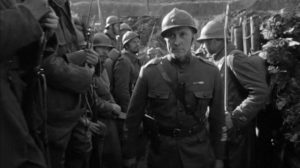
‘Paths of Glory’ (United Artists)
Directed by: Stanley Kubrick
An innovative and thrilling anti-war film that doubles as a compelling courtroom drama, “Paths of Glory” is Stanley Kubrick’s first masterpiece and it is a work of great spectacle and emotional depth. “Indifferent to the plight of the men bogged down in the hell of the trenches, the French military elite incentivize their upper ranks with the promise of prestigious promotions – regardless of the outcome – in order to break the impasse. Colonel Dax (Kirk Douglas) is subsequently ordered by General Paul Mireau (George Macready) to launch an impossible attack on the heavily fortified, key German position of Anthill and Dax is in no position to refuse the suicidal assignment. In return for their service, a few of Dax’s soldiers are scapegoated and he is forced to mount a defense against his own egomaniacal superiors and their insatiable hunger for glory.” (From IMDb).
57. Come and See (1985)

‘Come and See’ (Sovexportfilm)
Directed by: Elem Kilmov
A harrowing picture of World War II, “Come and See” is a brutally realistic and disturbing film that sheds a light on the terrible experiences that common people face during war. Its powerful but horrific images stay with viewers long after the credits roll. “During WWII, a Belarusian boy (Aleksey Kravchenko) is thrust into the atrocities of war, fighting with a hopelessly unequipped Soviet resistance movement against ruthless German forces. Witnessing scenes of abject terror and surviving horrifying situations, he loses his innocence and then his mind.” (From IMDb).
56. In the Mood For Love (2000)
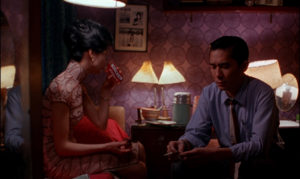
‘In the Mood For Love’ (GEM Entertainment)
Directed by: Wong Kar-Wai
A stunningly beautiful and visually striking film, Wong Kar Wai’s “In the Mood For Love” is a poetic masterpiece that captivates its audience with elegant cinematography and production design and two top-notch performances from Maggie Cheung and Tony Chiu-Wai Leung. “Two married couples, the Chans and the Chows, move in next door to each other. Mr. Chan is hardly around, regularly disappearing overseas on business. Mrs. Chow works odd hours and also tends to go overseas a lot. Mrs. Chan (Maggie Cheung) and Mr. Chow (Tony Chiu-Wai Leung) are initially just neighbors but over time a friendship blossoms, and then develops into something more.” (From IMDb).
55. Double Indemnity (1944)
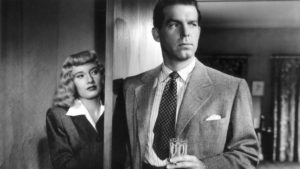
‘Double Indemnity’ (Paramount)
Directed by: Billy Wilder
One of the greatest film-noirs, “Double Indemnity” is constantly thrilling and this devilishly cynical film is a murder mystery at its finest. “In 1938, Walter Neff (Fred MacMurray), an experienced salesman of the Pacific All Risk Insurance Co., meets the seductive wife of one of his clients, Phyllis Dietrichson (Barbara Stanwyck), and they have an affair. Phyllis proposes to kill her husband to receive the proceeds of an accident insurance policy and Walter devises a scheme to receive twice the amount based on a double indemnity clause. When Mr. Dietrichson is found dead on a train track, the police accept the determination of accidental death. However, the insurance analyst and Walter’s best friend Barton Keyes (Edward G. Robinson) does not buy the story and suspects that Phyllis has murdered her husband with the help of another man.” (From IMDb).
54. Barry Lyndon (1975)

‘Barry Lyndon’ (Warner Bros.)
Directed by: Stanley Kubrick
A film where almost every frame looks like a Victorian painting (John Alcott won an Oscar for his lensing work on this film), “Barry Lyndon” is one of Stanley Kubrick’s more underrated films (if there is such a thing) and this period epic is always fascinating. “In the eighteenth century, in a small village in Ireland, Redmond Barry (Ryan O’Neal) is a young farm boy in love with his cousin Nora Brady (Gay Hamilton). When Nora gets engaged to British Captain John Quin (Leonard Rossiter), Barry challenges him to a duel of pistols. He wins and escapes to Dublin, but is robbed on the road. Without an alternative, Barry joins the British Army to fight in the Seven Years War. He deserts and is forced to join the Prussian Army, where he saves the life of his Captain and becomes his protégé and spy of Irish gambler Chevalier de Balibari (Patrick Magee). He helps Chevalier and becomes his associate until he decides to marry the wealthy Lady Lyndon (Marisa Berenson). They move to England and Barry, in his obsession of nobility, dissipates her fortune and makes a dangerous and revengeful enemy.” (From IMDb).
53. Raiders of the Lost Ark (1981)

‘Raiders of the Lost Ark’ (Paramount)
Directed by: Steven Spielberg
One of the most deliriously entertaining movies of all-time, “Raiders of the Lost Ark” is Spielberg’s second-greatest adventure film (A close second, but I am slightly partial to “Jurassic Park”. Jaws is a close third IMO) and, like the best of Spielberg adventures, gives the viewer a childlike sense of wonder and awe. “As the Third Reich continues its reign of terror, Adolf Hitler is on a quest for the legendary Ark of the Covenant- resting place of the Ten Commandments- whose supernatural powers, legend says, can wipe out entire armies. The U.S. Government turns to Dr. Indiana Jones (Harrison Ford) for the mission. Relentlessly pursued by Hitler’s henchmen, Indy infiltrates their massive digging operation in a race against time to discover the Well of the Souls, where the Ark has lain undisturbed for centuries.” (From IMDb).
52. Andrei Rublev (1966)
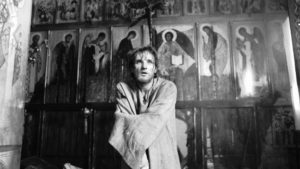
‘Andrei Rublev’ (Mosfilm)
Directed by: Andrei Tarkovsky
A biographical portrait of one of the, if not the, greatest iconographers of the medieval era, “Andrei Rublev” is a very human film that needs to be experienced. “The life and times of Andrei Rublev, (Anatoliy Solonitsyn) Russian iconographer of the early-15th century. Over seven periods in his life, spanning 1400 to 1424, we see the history of Russia, the power struggles, the role of the church and religion and Rublev’s dedication to his calling.” (From IMDb).
51. The 400 Blows (1959)
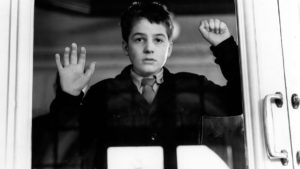
‘The 400 Blows’ (Cocinor)
Directed by: Francois Truffaut
An affecting portrait of a troubled childhood, “The 400 Blows” is the film that gave the French New Wave movement international recognition and it has knowing intelligence in portraying small moments as the events that shape a young person’s life. It also features one of the greatest child performances ever from Jean-Pierre Leaud. “Seemingly in constant trouble at school, 14-year-old Antoine Doinel (Jean-Pierre Leaud) returns at the end of every day to a drab, unhappy home life. His parents (Claire Maurier and Albert Remy) have little money and he sleeps on a couch that’s been pushed into the kitchen. His parents bicker constantly and he knows his mother is having an affair. He decides to skip school and begins a downward spiral of lies and theft. His parents are at their wits’ end, and after he’s stopped by the police, they decide the best thing would be to let Antoine face the consequences.” (From IMDb).
50. The General (1926)
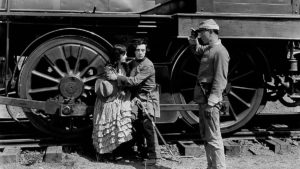
‘The General’ (United Artists)
Directed by: Buster Keaton
A thrilling film that contains some top-notch stunt work and practical effects, “The General” is a great comedy-adventure that set the stage for the grand action set-pieces we see throughout films today. “1862, Georgia, USA. The American Civil War is in its second year and Johnnie Gray (Buster Keaton) is barred from enlisting. He is a train engineer and the Confederate Army feel he is more valuable to the Southern cause in his current role than in the army. This frustrates Johnnie and has estranged him from his sweetheart Annabelle (Marion Mack), who views him as a coward. Then his beloved engine, The General, is stolen by Union spies and is heading for Union lines. Moreover, Annabelle is on board. Johnnie sets off after the two loves of his life.” (From IMDb).
49. Wild Strawberries (1957)

‘Wild Strawberries’ (Svensk)
Directed by: Ingmar Bergman
“Wild Strawberries”, with its dream sequences and flashbacks, is a thoughtful depiction of reconciling with your past and this symbolism-heavy film is a touching picture about love and loss. “Dr. Isak Borg (Victor Sjostrom), 78, is a renowned physician and researcher. His life’s experiences have left him cold, distant and uncaring. Now he is traveling to be awarded an honorary degree by a university, a reward for his life’s work. Driving with his daughter-in-law Marianne (Ingrid Thulin), currently estranged from his son Ewald (whose personality seems to be following that of his father’s), he finds himself reminiscing about his past, especially his 20s. He has also been having strange dreams, dreams that remind him of the person he has become, and potentially what lies ahead for him.” (From IMDb).
48. Schindler’s List (1993)
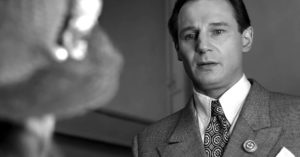
‘Schindler’s List’ (Universal)
Directed by: Steven Spielberg
A gutting, heart-wrenching experience, “Schindler’s List” is Spielberg’s most moving work and the film is a powerful, humanist story with Liam Neeson’s greatest performance and an all-time great performance from Ralph Fiennes. “Oskar Schindler (Liam Neeson) is a vain and greedy German businessman who becomes an unlikely humanitarian amid the barbaric German Nazi reign when he feels compelled to turn his factory into a refuge for Jews. Based on the true story of Oskar Schindler who managed to save about 1100 Jews from being gassed at the Auschwitz concentration camp, it is a testament to the good in all of us.” (From IMDb).
47. The Passion of Joan of Arc (1928)
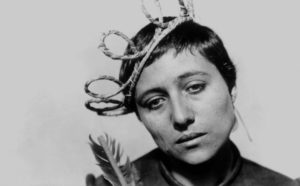
‘The Passion of Joan of Arc’ (Gaumont)
Directed by: Carl Theodor Dreyer
Featuring an affecting and incredible performance from Maria Falconetti (in her only performance that can be seen today), “The Passion of Joan of Arc” is beloved by critics and was voted the 8th greatest film of the century by a 2000 Village Voice Poll of dozens of critics. “In 1431, Jeanne d’Arc (Maria Falconetti) is placed on trial on charges of heresy. The ecclesiastical jurists attempt to force Jeanne to recant her claims of holy visions. (From IMDb).
46. The Great Dictator (1940)
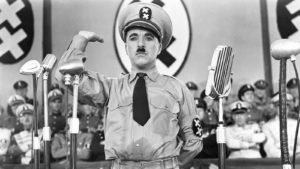
‘The Great Dictator’ (United Artists)
Directed by: Charlie Chaplin
A passionately anti-fascist film, “The Great Dictator” was released at the height of Hitler’s power and was a political film at a time when political films were discouraged in Hollywood. The final speech at the end of the film is especially impactful. “20 years after the end of WWI, in which the nation of Tomainia was on the losing side, Adenoid Hynkel (Charlie Chaplin) has risen to power as the ruthless dictator of the country. He believes in a pure Aryan state and the decimation of the Jews. This situation is unknown to a simple Jewish Tomainian barber (Charlie Chaplin) who has been hospitalized since a WWI battle. Upon his release the barber, who had been suffering from memory loss about the war, is shown the new persecuted life of the Jews by many living in the Jewish ghetto, including a washerwoman named Hannah (Paulette Goddard) with whom he begins a relationship.” (From IMDb).
45. The Gold Rush (1925)

‘The Gold Rush’ (United Artists)
Directed by: Charlie Chaplin
Hilarious but with touches of melancholy (I’m realizing that description could work for every Chaplin movie), “The Gold Rush” is one of Chaplin’s best works and is part of a quartet of Chaplin masterpieces that include “City Lights”, “Modern Times” and the previously-mentioned “The Great Dictator”. “The Little Tramp (Charlie Chaplin) goes prospecting for gold in the Klondike. Conditions are harsh, there is little in the way of comfort or food and even less it seems in the way of gold. Thanksgiving dinner for himself and Big Jim McKay (Mack Swain) consists of a boiled boot. Once in town, he meets the beautiful Georgia (Georgia Hale) at the Monte Carlo dance hall. He finds himself in competition with the ladies man (Malcolm Waite) who has his eyes on Georgia as well. Meanwhile, Black Larsen (Tom Murray) – wanted by the police – tries to steal Big Jim McKay’s claim. Big Jim tries to stop him but knocked unconscious, he loses his memory. Back in town, the little tramp tries to impress Georgia. (From IMDb).
44. Stalker (1979)
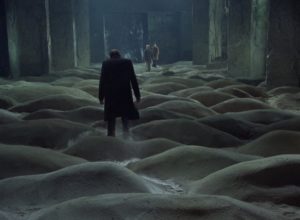
‘Stalker’ (Mosfilm)
Directed by: Andrei Tarkovsky
A meditative sci-fi film, “Stalker” is an existential film that draws the viewer into the world it presents. The film is a spiritual, humanist epic and has scenes in both color and black & white. “In the heart of the bleak and barren Zone–an out-of-bounds wilderness, and the cancerous epicenter of an unspeakable tragedy–lies the mystical location people refer to only as “The Room”. Imbued with the unfathomable capacity for granting one’s impatient wishes, two men, the Writer (Anatoliy Solonitsyn) and the Professor (Nikolay Grenko), enlist the help of the altruistic guide, Stalker (Aleksandr Kaydanovskiy), to visit the restricted area. In high hopes of finding inspiration and enlightenment, the ambitious dreamers stick to their experienced tracker until they arrive at the alleged source of metaphysical power; however, are they worthy of the ultimate truth?” (From IMDb).
43. Ikiru (1952)
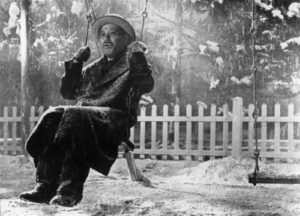
‘Ikiru’ (Toho)
Directed by: Akira Kurosawa
A moving film about a man with terminal cancer that is more restrained than those usually very treacly films, “Ikiru” is Kurosawa’s most emotionally affecting film and it is probably the greatest film about a person with terminal cancer (Fun fact: the Hindi film “Anand” (1971) is loosely based off this film). “Kanji Watanabe (Takashi Shimura) is a civil servant. He has worked in the same department for 30 years. His life is pretty boring and monotonous, though he once used to have passion and drive. Then one day he discovers that he has stomach cancer and has less than a year to live. After the initial depression he sets about living for the first time in over 20 years. Then he realizes that his limited time left is not just for living life to the full but to leave something meaningful behind.” (From IMDb).
42. The Seventh Seal (1957)
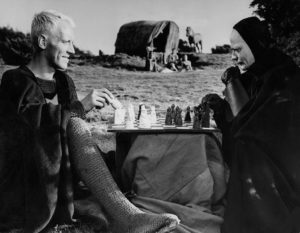
‘The Seventh Seal’ (Svensk)
Directed by: Ingmar Bergman
An existential medieval adventure, “The Seventh Seal” is a thought-provoking exploration of a man’s search for meaning in life. It is very allegorical and the scenes of Antonius Block and Death playing chess are some of the most iconic ever. “Returning home from the Crusades, Swedish knight Antonius Block (Max von Sydow) and his squire Jöns (Gunnar Bjornstrand) find the land ravaged by the plague. Block finds that people everywhere are living in fear believing it is God’s punishment and that the end has come. Block has lost his faith and is looking for answers so when Death (Bengt Ekerot) comes for him the knight challenges him to a game of chess. The countryside is bleak and many search for answers though none seem to be found.” (From IMDb).
41. Persona (1966)
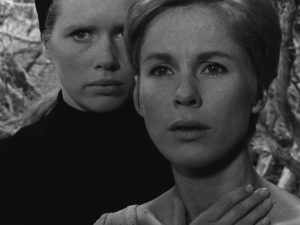
‘Persona’ (Svensk)
Directed by: Ingmar Bergman
Featuring two spectacular performances from Bergman regulars Bibi Andersson and Liv Ullmann, “Persona” is the 9-time Oscar nominated Bergman’s most critically-acclaimed film his films “Through a Glass Darkly” (1961) and “Fanny and Alexander” (1982) did win Best Foreign-Language Film). “A young nurse, Alma (Bibi Andersson), is put in charge of Elisabeth Vogler (Liv Ullmann): an actress who is seemingly healthy in all respects, but will not talk. As they spend time together, Alma speaks to Elisabeth constantly, never receiving any answer. Alma eventually confesses her secrets to a seemingly sympathetic Elisabeth and finds that her own personality is being submerged into Elisabeth’s persona.” (From IMDb).
40. The Third Man (1949)
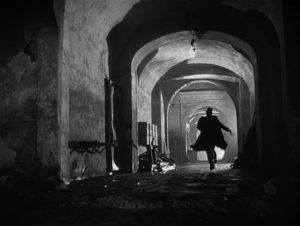
‘The Third Man’ (British Lion)
Directed by: Carol Reed
With a beautifully-shot Vienna (Robert Krasker won the film’s only Oscar) and a great Anton Karas score on the zither, “The Third Man” is the greatest film that Orson Welles was a part of but did not direct and is a fascinating noir with a riveting Graham Greene screenplay. “An out of work pulp fiction novelist, Holly Martins (Joseph Cotten), arrives in a post war Vienna divided into sectors by the victorious allies, and where a shortage of supplies has led to a flourishing black market. He arrives at the invitation of an ex-school friend, Harry Lime (Orson Welles), who has offered him a job, only to discover that Lime has recently died in a peculiar traffic accident. From talking to Lime’s friends and associates Martins soon notices that some of the stories are inconsistent, and determines to discover what really happened to Harry Lime.” (From IMDb).
39. Blade Runner (1982)
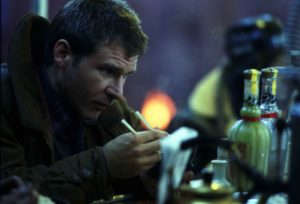
‘Blade Runner’ (Warner Bros.)
Directed by: Ridley Scott
With an amazing score by Vangelis (he also composed the iconic theme to “Chariots of Fire” (1981)) and eye-catching visuals, “Blade Runner” is a sci-fi masterpiece that harnesses and transcends the trappings of the genre. “In a cyberpunk vision of the future, man has developed the technology to create replicants – humanoid androids with short, fixed lifespans – which are illegal on Earth, but are used in the off-world colonies. In Los Angeles, California, 2019, Rick Deckard (Harrison Ford) is a “blade runner”, a cop who specializes in terminating replicants. He is forced to come out of retirement when four replicants escape from an off-world colony and come to Earth.” (From IMDb).
38. Chinatown (1974)
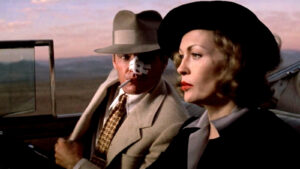
‘Chinatown’ (Paramount)
Directed by: Roman Polanski
The ultimate neo-noir, or at least the most famous one, “Chinatown” is driven by an all-time great Robert Towne screenplay, a magnificent Jerry Goldsmith score, and a pair of magnetic performances from Jack Nicholson and Faye Dunaway (‘The Treasure of the Sierra Madre’ director John Huston delivers a great performance as well). “Los Angeles detective Jake Gittes (Jack Nicholson) is hired by a ‘Mrs. Mulwray’ to spy on her husband (Darrell Zwerling). Shortly after Gittes is hired, the real Mrs. Mulwray (Faye Dunaway) appears in his office threatening to sue if he doesn’t drop the case immediately. Gittes pursues the case anyway, slowly uncovering a vast conspiracy centering on water management, state and municipal corruption, land use, and real estate; and involving at least one murder. (From IMDb).
37. Spirited Away (2001)

‘Spirited Away’ (Studio Ghibli)
Directed by: Hayao Miyazaki
A visually breathtaking animated masterpiece, “Spirited Away” is full of multi-dimensional characters, emotional moments that don’t resort to schlock (the train scene is indelible), and a beautiful score from Joe Hisaishi, the always-reliable composer of Miyazaki films. “10-year-old Chihiro (Rumi Hiiragi) and her parents stumble upon a seemingly abandoned amusement park. After her mother and father are turned into giant pigs, Chihiro meets the mysterious Haku (Miyu Irino), who explains that the park is a resort for supernatural beings who need a break from their time spent in the earthly realm, and that she must work there to free herself and her parents.” (From IMDb).
36. Tokyo Story (1953)

‘Tokyo Story’ (Shochiku)
Directed by: Yasujiro Ozu
One of the few films that have profoundly affected me, “Tokyo Story” is a quiet but powerful film about age, loss, and children drifting away from their parents. It’s unique in both its depiction of a family’s daily, seemingly mundane life and in its universal emotional impact. “An elderly couple, Shukishi (Chishu Ryu) and Tomi (Chieko Higashiyama), travel from Hiroshima to Tokyo to visit their children. The trip is arduous for the humble, elderly couple who are keen to see their children again. Their son, Koichi (So Yamamura), is a doctor and is often away from home. Their daughter Shige (Haruko Sugimura) finds their visit to be a costly imposition on her time. The only person who seems to care about them is their widowed daughter-in-law Noriko (Setsuko Hara). Their stay in Tokyo proves to be a sad one as they soon come to realize they are not particularly welcome and that their children see the visit more as a nuisance than anything else.” (From IMDb).
35. A Clockwork Orange (1971)
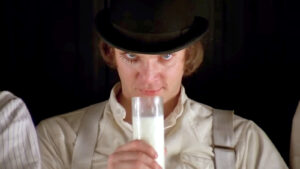
‘A Clockwork Orange’ (Warner Bros.)
Directed by: Stanley Kubrick
So disturbing it was banned in several countries, “A Clockwork Orange” is a satirical portrait of a sadistic man that does not shy away from violence but also presents a compelling picture that demands serious thought. People love it and hate it but one thing’s for sure, you will never see the song ‘Singin in the Rain’ the same way again. “In the future, the violent and psychopath delinquent Alex (Malcolm McDowell), leader of a gang of ultra-violent criminal teenagers who kill, steal and rape, falls into the hands of the police. Arrested, he receives the option to participate in a program developed by the government that can reduce his time in jail. Alex turns guinea pig for experiments intended to curb the destructive impulses of men and solve the society’s crime problems” (From IMDb).
34. Once Upon a Time in America (1984)

‘Once Upon a Time in America’ (Warner Bros.)
Directed by: Sergio Leone
A gangster epic that takes place over 60 years, “Once Upon a Time in America” features one of the greatest scores from one of the greatest composers (RIP Ennio Morricone) and great performances from Robert De Niro, James Woods, Joe Pesci, and Tuesday Weld. “Epic, episodic, tale of the lives of a small group of New York City Jewish gangsters spanning over 40 years. Told mostly in flashbacks and flash-forwards, the movie centers on small-time hood David ‘Noodles’ Aaronson (Robert De Niro) and his lifelong partners in crime; Max (James Woods), Cockeye (William Forsythe) and Patsy (James Hayden) and their friends from growing up in the rough Jewish neighborhood of New York’s Lower East Side in the 1920s, to the last years of Prohibition in the early 1930s, and then to the late 1960s where an elderly Noodles returns to New York after many years in hiding to look into the past. (From IMDb).
33. The Apartment (1960)
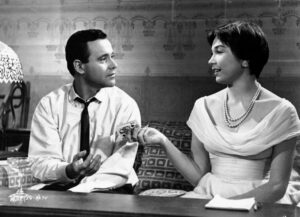
‘The Apartment’ (United Artists)
Directed by: Billy Wilder
One of the greatest romantic-comedies, “The Apartment” deftly balances hilarity and seriousness with a great script from Wilder and I. A. L. Diamond (who also worked with Wilder on ‘Some Like it Hot’) and two spectacular performances from Jack Lemmon and Shirley MacLaine. “Insurance worker C.C. Baxter (Jack Lemmon) lends his Upper West Side apartment to company bosses to use for extramarital affairs. When his manager Mr. Sheldrake (Fred MacMurray) begins using Baxter’s apartment in exchange for promoting him, Baxter is disappointed to learn that Sheldrake’s mistress is Fran Kubelik (Shirley MacLaine), the elevator girl at work whom Baxter is interested in himself. Soon Baxter must decide between the girl he loves and the advancement of his career.” (From IMDb).
32. Metropolis (1927)
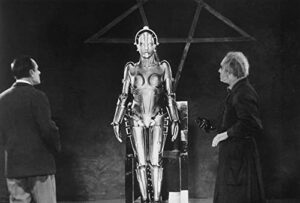
‘Metropolis’ (Universum)
Directed by: Fritz Lang
With production design that was ahead of its time, “Metropolis” is an oft-referenced and stunning film that has greatly influenced sci-fi cinema and cinema as a whole. It deftly balances thrills and a political message that serves as a time capsule. The plot detail about a robot impersonating an important figure is especially timely in the age of A.I. and it leaves the viewer astounded at the film’s level of imagination. “In the future, the society of Metropolis is divided in two social classes: the workers, who live in the underground below the machines level, and the dominant classes that lives in the surface. The workers are controlled by their leader Maria (Brigitte Helm), who wants to find a mediator between the upper class lords and the workers, since she believes that a heart would be necessary between brains and muscles. Maria meets Freder Fredersen (Gustav Frohlich), the son of the Lord of Metropolis Johann Fredersen (Alfred Abel), in a meeting of the workers, and they fall in love for each other. Meanwhile, Johann decides that the workers are no longer necessary for Metropolis, and uses a robot pretending to be Maria to promote a revolution of the working class and eliminate them.” (From IMDb).
31. Raging Bull (1980)
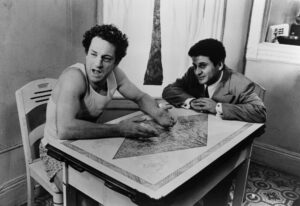
‘Raging Bull’ (United Artists)
Directed by: Martin Scorsese
Featuring an Oscar-winning Robert De Niro as the almost Shakespearean tragic hero Jake La Motta, “Raging Bull” is one of Scorsese’s finest works with its brutally realistic boxing sequences, a top-notch Paul Schrader script (Schrader worked with Scorsese on Taxi Driver (1976) as well), and riveting performances from Joe Pesci and Cathy Moriarty. “When Jake LaMotta (Robert De Niro) steps into a boxing ring and obliterates his opponent, he’s a prizefighter. But when he treats his family and friends the same way, he’s a ticking time bomb, ready to go off at any moment. Though LaMotta wants his family’s love, something always seems to come between them. Perhaps it’s his violent bouts of paranoia and jealousy. This kind of rage helped make him a champ, but in real life, he winds up in the ring alone.” (From IMDb).
30. Alien (1979)

‘Alien’ (20th Century Fox)
Directed by: Ridley Scott
One of the greatest creature-feature horror films, “Alien” is essentially a haunted-house film in a sleek, impeccably-designed spaceship. The thrills hold up to this day and the film keeps you guessing until the very end. “In the distant future, the crew (Tom Skerritt, Sigourney Weaver, Veronica Cartwright, Harry Dean Stanton, John Hurt, Ian Holm, Yaphet Kotto) of the commercial spaceship Nostromo are on their way home when they pick up a distress call from a distant moon. The crew are under obligation to investigate and the spaceship descends on the moon afterwards. After a rough landing, three crew members leave the spaceship to explore the area on the moon. At the same time as they discover a hive colony of some unknown creature, the ship’s computer deciphers the message to be a warning, not a distress call. When one of the eggs is disturbed, the crew realizes that they are not alone on the spaceship and they must deal with the consequences.” (From IMDb).
29. Some Like It Hot (1959)

‘Some Like it Hot’ (United Artists)
Directed by: Billy Wilder
Hilarious and smart, “Some Like it Hot” is immensely satisfying, boasts three brilliant performances from Jack Lemmon, Tony Curtis, and Marilyn Monroe, and moves at a lightning-quick pace that keeps you smiling, if not laughing your head off, for most of the two-hour runtime. “After two Chicago musicians, Joe (Tony Curtis) and Jerry (Jack Lemmon), witness the St. Valentine’s Day massacre, they want to get out of town and get away from the gangster responsible, Spats Colombo (George Raft). They’re desperate to get a gig out of town but the only job they know of is in an all-girl band heading to Florida. They show up at the train station as Josephine and Daphne, the replacement saxophone and bass players. They certainly enjoy being around the girls, especially Sugar Kane Kowalczyk (Marilyn Monroe) who sings and plays the ukulele. Joe in particular sets out to woo her while Jerry/Daphne is wooed by a millionaire, Osgood Fielding III (Joe E. Brown). Mayhem ensues as the two men try to keep their true identities hidden and Spats Colombo and his crew show up for a meeting with several other crime lords. (From IMDb).
28. North by Northwest (1959)
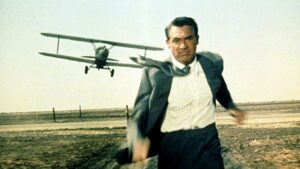
‘North by Northwest’ (MGM)
Directed by: Alfred Hitchcock
Like all of the best Hitchcock masterpieces, “North by Northwest” perfectly balances rollicking entertainment and boundary-pushing “high art”. The “Master of Suspense” is near the height of his powers in this film and, as a result, the audience is on the edge of their seats throughout the film. As an added bonus, this is also one of Hitchcock’s funnier films and if Cary Grant’s one-liners don’t have you laughing I don’t know what will. “Madison Avenue advertising man Roger Thornhill (Cary Grant) finds himself thrust into the world of spies when he is mistaken for a man by the name of George Kaplan. Foreign spy Philip Vandamm (James Mason) and his henchman Leonard (Martin Landau) try to eliminate him but when Thornhill tries to make sense of the case, he is framed for murder. Now on the run from the police, he manages to board the 20th Century Limited bound for Chicago where he meets a beautiful blond, Eve Kendall (Eva Marie Saint), who helps him to evade the authorities. His world is turned upside down yet again when he learns that Eve isn’t the innocent bystander he thought she was.” (From IMDb).
27. The Shining (1980)

‘The Shining’ (Warner Bros.)
Directed by: Stanley Kubrick
A masterclass in how to create dread, “The Shining” was Kubrick’s first and only foray into horror and it paid off spectacularly. Though Stephen King notoriously hates the film, Kubrick took the haunting atmosphere of that novel and amplified it while showing less. Jack Nicholson’s unhinged performance only adds to the unease and it is a marvel to watch. “With wife Wendy (Shelley Duvall) and psychic son Danny (Danny Lloyd) in tow, frustrated writer Jack Torrance (Jack Nicholson) takes a job as the winter caretaker at the opulently ominous, mountain-locked Overlook Hotel so that he can write in peace. Before the Overlook is vacated for the Torrances, the manager (Barry Nelson) informs Jack that a previous caretaker went crazy and slaughtered his family; Jack thinks it’s no problem, but Danny’s “shining” hints otherwise.” (From IMDb).
26. M (1931)
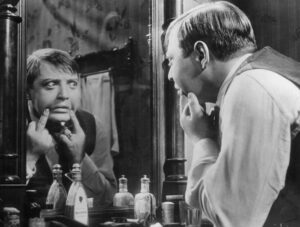
‘M’ (Vereinigte)
Directed by: Fritz Lang
One of the most influential psychological thrillers, “M” was ahead of its time in its ability to create an indelible sense of menace. It was Germany’s first sound film and one of the first great “talkies”. “In Berlin in the early 1930’s, children are being lured to their death by a psychopathic killer (Peter Lorre). In the space of a year, 8 children have been murdered. The police have redoubled their efforts to find the guilty man but have yet to find him and citizens are beginning to dispense their own justice on otherwise innocent people. The heads of the city’s criminal element are paying a high price due to the increased police presence and decide to find the psychopath on their own.” (From IMDb).
25. The Good, the Bad and the Ugly (1966)

‘The Good, the Bad and the Ugly’ (PEA)
Directed by: Sergio Leone
Probably the most well-known Western ever made, “The Good, the Bad and the Ugly” is an action-packed and darkly comic adventure that is unabashedly entertaining. Leone’s mastery of pacing and timing is on full display throughout the film, but most notably in the iconic climactic sequence. “During the American Civil War, three men set off to find two hundred thousand dollars in buried gold coins. Tuco (Eli Wallach) and Blondie (Clint Eastwood) have known each other for some time now having used the reward on Tuco’s head as a way of earning money. They come across a dying man, Bill Carson (Antonio Casale), who tells them of a treasure in gold coins. By chance, he tells Tuco the name of the cemetery and tells Blondie the name of the grave where the gold is buried. Now rivals, the two men have good reason to keep each other alive. The third man, Angel Eyes (Lee Van Cleef), hears of the gold stash from someone he’s been hired to kill. All he knows is to look for for someone named Bill Carson.” (From IMDb).
24. Rashomon (1950)

‘Rashomon’ (Daiei)
Directed by: Akira Kurosawa
Kurosawa’s first masterpiece, “Rashomon” was one of the first notable films to examine the nature of truth and one of the first to feature differing testimonies of an event. It is a film that will keep you guessing throughout and it is recognized for introducing the Western world to Japanese cinema and non-Western cinema as a whole. “Under Kyoto’s once-glorious front gate, a poor woodcutter (Takashi Shimura) and a faithful priest (Minoru Chiaki) gather around a feeble campfire to share with a wet commoner (Kichijiro Ueda) their take on the mysterious murder of a valiant samurai (Masayuki Mori) in a lush bamboo forest, and the brutal sexual assault of his wife (Machiko Kyo) by the notorious bandit, Tajomaru (Toshiro Mifune). Before court and through a series of uncomfortable flashbacks, strikingly different points-of-view inextricably interweave with half-truths, cover-ups, and the supernatural, to further blur the lines between memory and fact.” (From IMDb).
23. Star Wars (1977)

‘Star Wars’ (20th Century Fox)
Directed by: George Lucas
A rip-roaring adventure full of wonder and amazement, “Star Wars” is a timeless film with unmatched technical brilliance and deeply human themes. John Williams adds an extra layer of “epic-ness” with his instantly recognizable leitmotifs that contribute to an already exhilarating space opera with robust characters that are deservedly iconic. “Luke Skywalker (Mark Hamill) joins forces with a Jedi Knight (Alec Guinness), a cocky pilot (Harrison Ford), a Wookiee (Peter Mayhew) and two droids (Anthony Daniels and Kenny Baker) to save the galaxy from the Empire’s world-destroying battle station, while also attempting to rescue Princess Leia (Carrie Fisher) from the mysterious Darth Vader (David Prowse; voice: James Earl Jones).” (From IMDb).
22. Lawrence of Arabia (1962)

‘Lawrence of Arabia’ (Columbia)
Directed by: David Lean
An epic with massive physical and emotional scope, “Lawrence of Arabia” is the epitome of how Hollywood films “used to me made”. Freddie Young (cinematography), Maurice Jarre (score), and Robert Bolt (screenplay), all frequent David Lean collaborators, are firing on all cylinders in this film, creating an experience that rightly won Best Picture. “Due to his knowledge of the native Bedouin tribes, British Lieutenant T.E. Lawrence (Peter O’ Toole) is sent to Arabia to find Prince Faisal (Alec Guinness) and serve as a liaison between the Arabs and the British in their fight against the Turks. With the aid of native Sherif Ali (Omar Sharif), Lawrence rebels against the orders of his superior officer and strikes out on a daring camel journey across the harsh desert to attack a well-guarded Turkish port.” (From IMDb).
21. One Flew Over the Cuckoo’s Nest (1975)

‘One Flew Over the Cuckoo’s Nest’ (United Artists)
Directed by: Milos Forman
A profound experience with spectacular performances, “One Flew Over the Cuckoo’s Nest” is Milos Forman’s best film and proves that he is one of the best directors in terms of being able to bring out great performances from his cast. Jack Nicholson and Louise Fletcher rightly deserved their Oscars and iconic status for their work in this film. “McMurphy (Jack Nicholson) has a criminal past and has once again gotten himself into trouble and is sentenced by the court. To escape labor duties in prison, McMurphy pleads insanity and is sent to a ward for the mentally unstable. Once here, McMurphy both endures and stands witness to the abuse and degradation of the oppressive Nurse Ratched (Louise Fletcher), who gains superiority and power through the flaws of the other inmates. McMurphy and the other inmates band together to make a rebellious stance against the atrocious Nurse.” (From IMDb).
20. Taxi Driver (1976)

‘Taxi Driver’ (Columbia)
Directed by: Martin Scorsese
An anarchic and disturbing masterpiece, “Taxi Driver” is a timeless film full of unease and human subjectivity that brings you into the mind of Robert De Niro’s Travis Bickle. Its themes of loneliness and depression are some that will never not be relevant. “Travis Bickle (Robert De Niro) is a lonely and insomniac ex-marine, who spends his nights driving his taxi throughout the shadowy streets of mid-70’s New York City. Travis is fed up with the society he finds himself surrounded by, wishing that a “real rain will come and wash all the scum off the streets”. But Travis’s personality sees him being unable to connect with virtually anyone, until he becomes infatuated with a blonde campaign worker named Betsy (Cybill Shepherd) and then later meets an adolescent prostitute named Iris (Jodie Foster). As Travis grows increasingly more paranoid of his situations, he begins to sees these relationships he develops as ‘missions’ of which he will need to be the savior.” (From IMDb).
19. Dr. Strangelove or: How I Learned to Stop Worrying and Love the Bomb (1964)

‘Dr. Strangelove Or: How I Learned to Stop Worrying and Love the Bomb’ (Columbia)
Directed by: Stanley Kubrick
Simultaneously biting and hilarious, “Dr. Strangelove Or: How I learned to Stop Worrying and Love the Bomb” is a powerful antiwar statement that still produces belly-laughs with its impeccably witty and knowing humor. “U.S. Air Force General Jack Ripper (Sterling Hayden) goes completely mad, and sends his bomber wing to destroy the U.S.S.R. He suspects that the communists are conspiring to pollute the “precious bodily fluids” of the American people. The U.S. president meets with his advisors, where the Soviet ambassador tells him that if the U.S.S.R. is hit by nuclear weapons, it will trigger a “Doomsday Machine” which will destroy all plant and animal life on Earth. Peter Sellers portrays the three men who might avert this tragedy: British Group Captain Lionel Mandrake, the only person with access to the demented Gen. Ripper; U.S. President Merkin Muffley, whose best attempts to divert disaster depend on placating a drunken Soviet Premier and the former Nazi genius Dr. Strangelove, who concludes that “such a device would not be a practical deterrent for reasons which at this moment must be all too obvious”. Will the bombers be stopped in time, or will General Jack Ripper succeed in destroying the world?” (From IMDb).
18. Once Upon a Time in the West (1968)
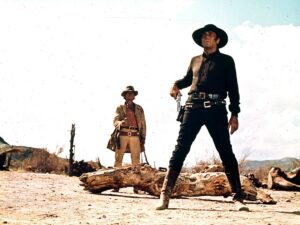
‘Once Upon a Time in the West’ (EIA)
Directed by: Sergio Leone
Featuring an unforgettable Henry Fonda performance, “Once Upon a Time in the West” is an amazing Western with an epic scope and memorable characters. The standoffs in this films are some of the most tense seen in any Western ever. “A young woman (Claudia Cardinale) leaves her old life behind for her new husband and a new future out West. When her train arrives, she finds him and his children murdered. A man – only known as Harmonica (Charles Bronson), knows Frank (Henry Fonda) did it, and goes after him. Just then, another outlaw – Cheyenne (James Robards) – appears intent on tracking down Frank. As good pursuit of Frank gets closer to him, Cheyenne leaves none of Frank’s associates alive.” (From IMDb).
17. Bicycle Thieves (1948)

‘Bicycle Thieves’ (ENIC)
Directed by: Vittorio De Sica
The ultimate Italian Neorealist film, “Bicycle Thieves” is a must-see movie about poverty and desperation that is one of the most human films ever made. This often heartbreaking experience is only amplified by Enzo Staiola’s work as the child Bruno. In depressed post-WWII Italy, an unemployed man named Antonio (Lamberto Maggiorani) finally gets a job, the only problem is that he needs a bicycle. He eventually gets a bike, but soon after, it is stolen. He and his son Bruno (Enzo Staiola) desperately comb the city of Rome looking for the one thing that can keep their family afloat.
16. Singin’ in the Rain (1952)
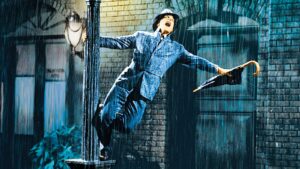
‘Singin’ in the Rain’ (MGM)
Directed by: Stanley Donen and Gene Kelly
One of the most joyous and euphoric movies ever made, “Singin’ in the Rain” is the archetypal musical: a fun, visually-impressive, and wholly satisfying experience filled with great songs. This film set the standard for most Hollywood musicals going forward. “1927: Don Lockwood (Gene Kelly) and Lina Lamont (Jean Hagen) are the darlings of the silent silver screen. Offscreen, Don, aided by his happy-go-lucky friend and piano accompanist, Cosmo Brown (Donald O’Connor), has to dodge Lina’s romantic overtures, especially when he falls for chorus girl Kathy Selden (Debbie Reynolds). With the advent of sound in motion pictures, it is decided to turn Don and Lina’s new film into a “talkie” and a musical at that. The only problem is Lina’s voice, which mere words cannot describe. Thus, Kathy is brought on to dub her speaking and singing voice in secret.” (From IMDb).
15. It’s a Wonderful Life (1946)
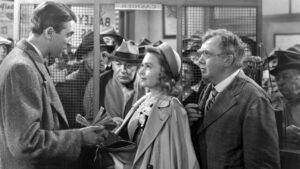
‘It’s a Wonderful Life’ (RKO Radio)
Directed by: Frank Capra
A movie that is great to watch all year round and should not be restricted to just Christmas, “It’s a Wonderful Life” is a movie that shines a light on why life is worth living and can serve as a pick-me-up in the lows of life. The film also contains one of the most immensely satisfying endings of all-time. “George Bailey (James Stewart) never got a chance to fulfill his life’s ambitions of exploring the world and building skyscrapers. As he watches his friends and family become success stories he dreads on running his fathers building and loan business, rivaling the grumpy old Mr. Potter (Lionel Barrymore). When a financial discrepancy puts George in a difficult position, an angel comes to show him what life would have been like if he had never been born.” (From IMDb).
14. Sunset Boulevard (1950)
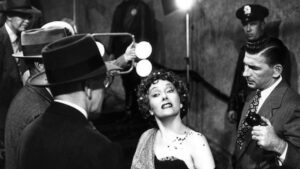
‘Sunset Boulevard’ (Paramount)
Directed by: Billy Wilder
One of the first great films that showed the dark side of Hollywood, “Sunset Boulevard” is my personal favorite film-noir with an enticingly dark screenplay from Billy Wilder and Charles Bracket and a scenery-chewing performance from Gloria Swanson as the forgotten film star Norma Desmond. “Desperate for cash, screenwriter Joe Gillis (William Holden) has a chance meeting with a faded silent film star (Gloria Swanson). Norma Desmond lives in her crumbling Sunset Boulevard mansion with only her butler (Erich von Stroheim) to keep her company. She has become a sad demented recluse convinced that the outside world is clamoring for her dramatic return. Enticing him with the prospect of script work she puts him up in her mansion and he becomes ever more involved and entangled in her life.” (From IMDb).
13. Citizen Kane (1941)
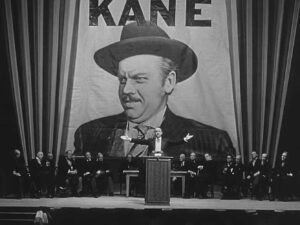
‘Citizen Kane’ (RKO Radio)
Directed by: Orson Welles
Widely-considered the greatest film of all-time, “Citizen Kane” is an undeniably great film with a main character that can lead to the audience drawing parallels between him and certain people and events that are relevant today. “When a reporter is assigned to decipher newspaper magnate Charles Foster Kane’s (Orson Welles) dying words, his investigation gradually reveals the fascinating portrait of a complex man who rose from obscurity to staggering heights. Though Kane’s friend and colleague Jedediah Leland (Joseph Cotten), and his mistress, Susan Alexander (Dorothy Comingore), shed fragments of light on Kane’s life, the reporter fears he may never penetrate the mystery of the elusive man’s final word, “Rosebud.” (From IMDb).
12. Vertigo (1958)
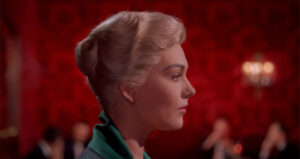
‘Vertigo’ (Paramount)
Directed by: Alfred Hitchcock
Obsession is one Hitchcock’s favorite themes and none of his films explore it better than “Vertigo”. This film was voted to be the greatest film of all-time according to the 2012 Sight and Sound Critics’ Poll and in addition to the film being a top-notch Hitchcock thriller, it also boasts some beautiful cinematography from frequent Hitchcock collaborator and Oscar winner, (for Hitchcock’s “To Catch a Thief”) Robert Burks. “John “Scottie” Ferguson (James Stewart) is a retired San Francisco police detective who suffers from acrophobia. A wealthy shipbuilder (Tom Helmore) who is an acquaintance from college days approaches Scottie and asks him to follow his beautiful wife, Madeleine (Kim Novak). He fears she is going insane, maybe even contemplating suicide, as he believes she has been possessed by a dead ancestor who committed suicide.” (From IMDb).
11. Rear Window (1954)
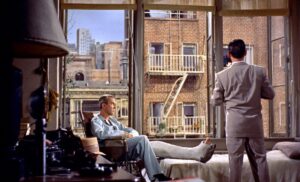
‘Rear Window’ (Paramount)
Directed by: Alfred Hitchcock
A master portrait of paranoia, Hitchcock’s “Rear Window” displays the director’s mastery of slowly ratcheting up the tension and increasing suspense. It’s impossible to take your attention away from this movie as the central mystery builds to its climax. “Professional photographer L.B. “Jeff” Jefferies (James Stewart) breaks his leg while getting an action shot at an auto race. Confined to his New York apartment, he spends his time looking out of the rear window observing the neighbors. He begins to suspect that a man across the courtyard may have murdered his wife. Jeff enlists the help of his high society fashion-consultant girlfriend Lisa Freemont (Grace Kelly) and his visiting nurse Stella (Thelma Ritter) to investigate.” (From IMDb).
10. 2001: a Space Odyssey (1968)

“2001: A Space Odyssey” (MGM)
Directed by: Stanley Kubrick
Probably the most thematically and technologically ambitious film I have ever seen, “2001: a Space Odyssey” is a movie that all film-lovers must see at least once as it is truly a singular experience. This was also the film that Kubrick won his first (and sadly his only) Oscar for as he nabbed the prize for Best Visual Effects. While the man deserved a Best Director win, the Best Visual Effects win was definitely deserved as this is one of the most technically innovative films of all time especially in its production design. “When a large black monolith is found beneath the surface of the moon, the reaction immediately is that it was intentionally buried. When the point of origin is confirmed as Jupiter, an expedition is sent in hopes of finding the source.” (From IMDb).
9. Goodfellas (1990)

‘Goodfellas’ (Warner Bros.)
Directed by: Martin Scorsese
The best of Scorsese’s gangster films, “Goodfellas” is a modern masterpiece and (arguably) the Italian-American maestro’s best film. With propulsive directing and a whip-smart screenplay from Scorsese and Nicholas Pileggi (who also wrote the book, “Wiseguy”, which the movie was based on), Goodfellas is an indelible film experience that takes its audience on an unforgettable ride. “The lowly, blue-collar side of New York’s Italian mafia is explored in this crime biopic of wiseguy Henry Hill (Ray Liotta). As he makes his way from strapping young petty criminal, to big-time thief, to middle-aged cocaine addict and dealer, the film explores in detail the rules and traditions of organized crime. Watching the rise and fall of Hill and his two counterparts, the slick jack-of-all-trades criminal Jimmy Conway (Robert De Niro) and the brutish, intimidating Tommy DeVito (Joe Pesci), this true story realistically explores the core, blue-collar part of the mob.” (From IMDb).
8. Modern Times (1936)

‘Modern Times’ (United Artists)
Directed by: Charlie Chaplin
The last film featuring Chaplin’s ‘Tramp’ character, “Modern Times” is a funny yet passionate film that deals with Chaplin’s concerns about industrialization taking jobs away from the people, which has become increasingly relevant with the rise of artificial intelligence. “The story begins on the life of a factory working who is employed on the assembly line. His job sees him screwing nuts at an ever-increasing rate as part of the assembly line as well as being subjected to new, untested inventions like an ‘automatic feeding machine’. This daily monotony pushes him over the edge and, after a lengthy stay in an asylum, is arrested for being mistakenly taken as an instigator at a communist rally. What follows is the factory worker meeting the love of his life, taking on several new jobs and trying to make what proves to be a difficult living.” (From IMDb).
7. Casablanca (1942)
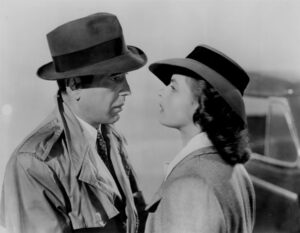
‘Casablanca’ (Warner Bros.)
Directed by: Michael Curtiz
Anchored by pitch-perfect performances from Humphrey Bogart and Ingrid Bergman and a screenplay that has not lost its effect even after over 75 years, “Casablanca” is a timeless masterpiece that is ever-quotable and impactful to this day. “The story of Rick Blaine (Humphrey Bogart), a cynical world-weary ex-patriate who runs a nightclub in Casablanca, Morocco during the early stages of WWII. Despite the pressure he constantly receives from the local authorities, Rick’s cafe has become a kind of haven for refugees seeking to obtain illicit letters that will help them escape to America. But when Ilsa (Ingrid Bergman), a former lover of Rick’s, and her husband (Paul Henreid), show up to his cafe one day, Rick faces a tough challenge which will bring up unforeseen complications.” (From IMDb).
6. Pulp Fiction (1994)

‘Pulp Fiction’ (Miramax)
Directed by: Quentin Tarantino
Violent, action-packed, and immensely entertaining, Tarantino did not suffer the sophomore slump with “Pulp Fiction”. Probably the most influential film of the last 30 years, Tarantino’s best film still has not lost any of the energy or novelty that thrilled audiences back in 1994. “Jules Winnfield (Samuel L. Jackson) and Vincent Vega (John Travolta) are two hit men who are out to retrieve a suitcase stolen from their employer, mob boss Marsellus Wallace (Ving Rhames). Wallace has also asked Vincent to take his wife Mia (Uma Thurman) out a few days later when Wallace himself will be out of town. Butch Coolidge (Bruce Willis) is an aging boxer who is paid by Wallace to lose his fight. The lives of these seemingly unrelated people are woven together comprising of a series of funny and bizarre incidents.” (From IMDb).
5. City Lights (1931)

‘City Lights’ (United Artists)
Directed by: Charlie Chaplin
One of the most heartwarming films I have ever seen, “City Lights” is Chaplin at his do-everything best juggling sweetness, slapstick comedy, and action to create a beautiful combination of all the things that have made the silent master so legendary almost 90 years later. “This classic story of love, tragedy and hope centers around a homeless tramp whom meets and instantly falls in love with a beautiful, albeit blind, flower seller (Virginia Cherrill). The tramp (Charlie Chaplin), desperate to win her love over, convinces the woman that he is a millionaire and can pay for her to get her sight back. We then follow the ebbs and flows of The Little Tramp’s adventures in his pursuit to make good on his promise to The Flower Girl.” (From IMDb).
4. Apocalypse Now (1979)

‘Apocalypse Now’ (United Artists)
Directed by: Francis Ford Coppola
Probably the quintessential psychological war movie, “Apocalypse Now” is a legendary film with massive and masterful performances from Marlon Brando, Martin Sheen, and Robert Duvall and iconic cinematography from Vittorio Storaro (who won an Oscar for his work here). This film is also an example of how behind-the-scenes factors can profoundly effect a film, and you can take a look at those stories in the documentary “Hearts of Darkness: A Filmmaker’s Apocalypse”. “The worn out and fatigued U.S Army captain Benjamin L. Willard (Martin Sheen) is sent on a harrowing and surreal mission into the deepest parts of the jungle during the height of the Vietnam War, with the objective of eliminating the rogue Walter E. Kurtz (Marlon Brando), a Green Beret officer who has completely lost his sanity. Together with a small squad of soldiers, Willard sets out by boat to travel upriver towards Kurtz’ base. But Willard soon eerily realizes that the closer he gets to his target, the more he seems himself in him.” (From IMDb).
3. Psycho (1960)
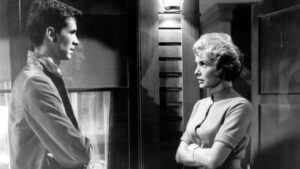
‘Psycho’ (Paramount)
Directed by: Alfred Hitchcock
As the proto-slasher film (many of the tropes seen throughout slasher films originated in this movie), “Psycho” is one of the most influential movies made yet its thrill factor exceeds that of any of the films that came after it thanks to Hitchcock’s legendary directing and mastery of suspense and an effortlessly creepy performance from Anthony Perkins as the iconic Norman Bates. “Phoenix office worker Marion Crane (Janet Leigh) is fed up with the way life has treated her. She has to meet her lover Sam (John Gavin) in lunch breaks, and they cannot get married because Sam has to give most of his money away in alimony. One Friday, Marion is trusted to bank forty thousand dollars by her employer. Seeing the opportunity to take the money and start a new life, Marion leaves town and heads towards Sam’s California store. Tired after the long drive and caught in a storm, she gets off the main highway and pulls into the Bates Motel. The motel is managed by a quiet young man called Norman (Anthony Perkins) who seems to be dominated by his mother.” (From IMDb).
2. Seven Samurai (1954)
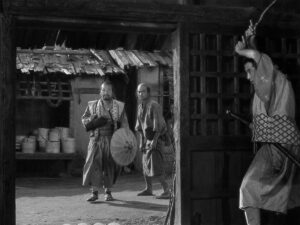
‘Seven Samurai’ (Toho)
Directed by: Akira Kurosawa
A movie who’s influence can be seen from “The Good, the Bad, and the Ugly” to “The Mandalorian”, “Seven Samurai” is arguably the most important action movie ever made as directors like George Lucas, Sergio Leone, and Steven Spielberg have all been majorly influenced by Kurosawa, and this film in particular, in their legendary work. “In 16th century Japan, farmers in a small village face the prospect of again losing their crops to a band of roving thieves. Their solution is to go to the nearest city and see if they can hire samurai to protect them. The farmers are poor and can only offer food and lodging but they soon recruit Kambei Shimada (Takashi Shimura) who determines that they will need a total of seven samurai to properly guard the village. Slowly, he recruits other samurai for their task and once complete, move to the village. There they teach the farmers basic self defense and fortify the village itself.” (From IMDb).
1.The Godfather (Parts I and II) (1972 and 1974)
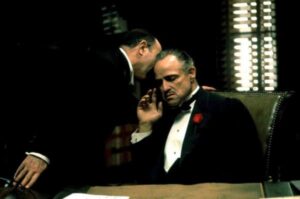
‘The Godfather’ (Paramount)

‘The Godfather Part II’ (Paramount)
Directed by: Francis Ford Coppola
Yes, I know, it is kind of cheating to put these two films at the top spot but I have always felt that they were kind of one film with an essentially uniform level of quality across the two films. Anyway, what can be said that hasn’t already been said about these films? Francis Ford Coppola’s innovative direction keeps the audience’s eyes locked on the screen at all times. The cast is full of some of the greatest actors of all-time and performers like Marlon Brando, Robert De Niro, Al Pacino, Robert Duvall, and Diane Keaton deliver some of the best performances of their careers. And, of course, Nino Rota’s sweeping orchestral score is iconic to this day and perfectly soundtracks the life and times of the Corleone mob family.
Find where to watch all of these films on Reelgood
